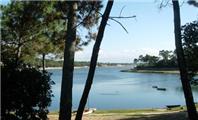So I thought I'd try out a new route today and instead of running straight from the front door I drove to a nearby lake, which is very popular with runners and walkers and which has a circumference of 6kms.
That was the first problem. If you can see 6 kms stretched out in front of you you'd never think of running it - it's a long way! First mental barrier erected.
The second thing was that it had had been raining all night, so the paths and trails were a mix of grit and sodden sand and full of puddles. Therefore much of the run involved changing stride to avoid the deep puddles or to negotiate stretches of loose sand.
Anyway I set off gently and felt fine. As it was first light on a Monday, and had only just stopped raining, there was no-one around except a few fishermen. It was quite pleasant, though I was constantly having to watch where I was going. Halfway round came up quite quickly which was encouraging, but then, about two-thirds the way round, I hit more loose sand and slowed considerably - both physically and mentally. It started to become hard and I literally couldn't see the end in sight (which was discouraging). I struggled on for a bit more and then stopped after 22 minutes of running feeling pretty annoyed with myself. Walked for 5 minutes to recover then ran the last bit.
Conclusions? Running on tarmac is easier than on loose surfaces. Running to a time goal may be easier than running to a distance goal (not sure about that). Running at a constant pace is much harder on trails and very difficult to control - bizarrely, when I reviewed the data I found that I was running more quickly on the trails than previously on tarmac, despite the sand and having to jump the puddles. In fact I was surprised (and encouraged) to see I was running at a sub 6 min/km pace on the trail compared with around 6:15 min/km on tarmac - which makes little sense as I felt I was running more slowly on the trail. So, final conclusion, you can't always trust what your body is telling you! 
Roll on run 3... 
